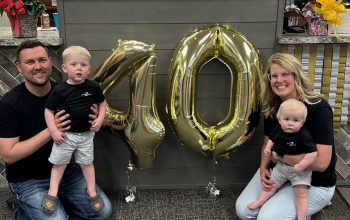In America, you may have to be 18 to leagally vote, but in many schools across the state of Iowa, and the nation, underage students still made their voices heard by casting their votes for either Donald Trump or Joe Biden in the days leading up to the November 3 in-person vote. That included the seventh and eighth grade students at Robert Blue Middle School in Jacob Groth’s Social Studies class. But, they didn’t do so without first learning what it really means to have the right to vote, how to understand the voting process, and how to make informed decisions about each candidate before making their choice.
“My job is not to teach them WHAT to think, but how to think UNBIASEDLY…(teaching this class) has even changed how I think,” Groth said. “Now when I go to vote, I’m not one or the other party, but I vote for who I think will do the best job.”
First and foremost, Groth is careful not to project his own opinions on the influential minds of his students. This class is about getting them to make up their own minds, not choosing a candidate based on what they hear their parents talking about, their friends talking about, or what they read on the internet. He wants them to really pay attention to the facts and prepare them to get involved and make an educated choice when they are old enough to actually have their vote counted in a real election.
As the students prepared to cast their vote Tuesday, Nov. 3…just like the rest of the nation, Groth gave them a “blind survey” prepared by Scholastic, a company that prepares numerous types of school learning materials for students of all ages. The purpose of the survey was to help students vote on which policies they believe in rather than which specific candidate. It asked which statements they agreed with on subjects like COVID, racial justice, the economy, climate change, and immigration. Two statements for each topic were given, and they had to check the one they most agreed with.
“Vote on the statement, not which side you think is Democrat or Republican,” Groth told his students as they started to take the survey. “It’s important what you believe…and the goal is to get you to vote on what you believe, not for who you think you like.”
As the students took a few minutes to read through the statement, Groth walked around the room, glancing at some of their answers.
“Some of you might be surprised,” he told them with a little grin.
At the completion of the survey, several students said they quickly caught on to which were Republican comments and which were Democrat policies. When he asked them how they knew, many said from hearing and seeing ad campaigns.
“I already knew what each of the candidates stand for,” added student Avery Weppel.
After reviewing the statements and policies, and learning which were said/believed by Trump and which were Biden’s, Groth asked the students who were surprised by the candidate they most agreed with. About half of the class raised their hands.
Groth reiterated the importance of voting for a candidate based on your agreement of beliefs and goals with them rather than basing it on being Republican or Democrat, by noting the words of George Washington in his Presidential exit speech who cautioned Americans about dividing into “teams.”
A second project Groth did with his seventh and eighth graders was a game board map, also developed by Scholastic. This provided a visual of the process of becoming President. It talked about the three things a candidate must be, as established by the U.S. Constitution – 1. You must be a natural born U.S. Citizen; 2. You must be at least 35 years old; and 3. You must be a U.S. resident for at least 14 consecutive years leading up to your candidacy. Groth really talked about the last one with the students, explaining that even though you are U.S. born, if you go live abroad for a year or two, and then want to return home and run for President right away – it may be different than when you left.
“Countries can change a lot in a year, especially after an election,” Groth commented.
That is why the third clause of the Constitution was set in place when running for President of the U.S.
Students also learned about winning the vote – Primaries and Caucuses, National Conventions, and the Electoral College (which is determined from the Census). He also explained why and how a President needs 270+ Electoral votes to win and why some states have more Electoral votes than others (based on their population).
The students were able to look at an online map Scholastic created (date unknown) that showed which states were running red (Republican) and which were showing blue (Democrat). It also showed the swing states as grey…and how important those states really are. Students could touch those states and turn them red or blue and immediately see how it affected the outcome of voting for the President of the United States. If all the red stayed red, and all the blue stayed blue, but this year they changed one swing state either Republican or Democrat, it flipped the outcome.
“One state, if it’s the right state, can change the vote,” Groth said, encouraging the students to change the color of states on the map to see for themselves.
In the 2016 election, Iowa was a swing state which Trump ended up winning. As of last week, the Scholastic map showed Biden with the lead.
Here is what really seemed to amaze the kids – Groth asked them, can you have more “votes” than the other candidate but still lose the election? The answer, he explained is “Yes,” and that’s exactly what happened in 2016 between Hillary Clinton and Donald Trump. Clinton had more than 65 million votes, and Trump just under 63 million…but Trump had more Electoral votes at 306. Trump also won Wright County in 2016 with 3,800 votes. Clinton recieved 1,896 votes in Wright County, Iowa.
No matter what each student believes, Groth reminded them that when it comes to politics, it’s important that they “attack the idea, not the person” when discussing those beliefs and their own personal views.
“I encourage you, though, to not be a one-issue voter,” said Groth.
When Groth gave the students some free time to practice “talking politics” in a respectful manner, there were a lot of impressive points made by the students to each other in support of both candidates. The general chatter seemed as though the majority thought Biden would be our next President. In a annonymous poll of students in one of Groth’s eighth grade classes, 12 voted for Biden and 10 voted for Trump – a very close call, just like the real election was suspected to be.
The entire RBMS student body was allowed to vote for President, Senator, and Representative.







